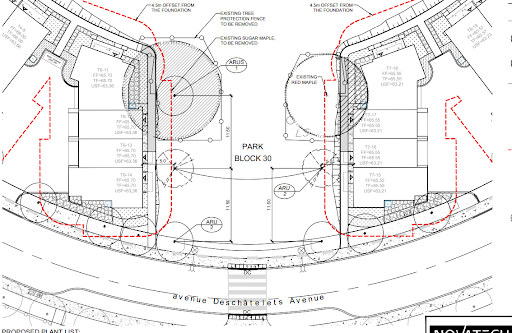Planning report: 2025-04
Submitted by John Dance on behalf of Planning Committee
1. Zoning By-law – Draft 2
- The City’s revised zoning by-law is now available for review. The planning committee recommends residents take the time to review the impact of proposed changed zoning on
their property and elsewhere in Old Ottawa East. - The new zoning is required to give effect to the new Official Plan, specifically to substantially increase the much-needed stock of housing in Ottawa.
- The “home” page for the proposal is https://engage.ottawa.ca/zoning but there is a specific reference (“interactive map”) that allows a resident to compare existing to proposed zoning for a particular property:
- The proposed changes are profound and not easy to understand. “R” (residential) zones will be called “N” (neighbourhood) zones. Generally, proposed allowed units for major OOE zones are substantially higher than current levels and, in some cases, have been bumped up by two levels (for instance, many R1 areas south of Clegg go to N3). Some exceptions are much of the area north of 417 and along Lees east of Main where the R4 would become N4 and the R1 areas of the Brantwood park area in the flood plain become N1.
- In response to the review of the first draft of the ZBL, the OOE planning committee argued that the revisions did not respect the Old Ottawa East Secondary Plan which was recently renewed through the Official Plan update.
- It appears that the only significant OOE change to proposed zoning in the second draft is that height limitations more in line with the current zoning are proposed in residential neighbourhoods.
- One concern raised by the planning committee is why in some
parts of OOE south of Clegg (the parts closer to Main Street) the
zoning has been bumped up two levels while the parts closer to
the Canal were bumped up just one level. - The committee continues to be concerned that the proposed zoning does not provide adequate space for canopy trees which are particularly needed in the core. A further concern is that the increased density is disproportionately being proposed for those neighbourhoods that already have had considerable intensification.
- Also, the City acknowledges that if the new zoning is approved in certain areas the density targets would be greatly exceeded if new builds replaced existing structures. However, the City argues that replacement of the existing structures will be a very gradual process so will not be disruptive. The City is not proposing any means to monitor growth in a community’s density, nor does it seem to have a good handle on what current densities are, how they’ve changed over the last 20 years, or what it would do when targets are met (for example, would they ban additional units?)
2. Phase 4 – Greystone Forecourt Towns – Rezoning Questions
- The OOE planning committee’s request that the Grande Allee width be respected with the location of the new Forecourt Towns has been ignored by City staff and The Regional Group.
- The only changes we’ve seen in the new plans are that one of the two heritage trees along the Allee in the Forecourt area is now proposed for removal and two additional trees will be planted. (From City planner: “[T]wo additional trees have now been added to frame the entrance to Forecourt Park, as requested at our last meeting with the Councillor’s Office. Please also note that the applicant is indicating the removal of a large existing Sugar Maple (Tree #1 – which was identified by the applicant’s forester as in declining and poor condition). City forestry staff are currently requesting additional information to confirm that a large transplant tree can be planted on-site as a replacement.”

- Regional is proposing to remove the large sugar maple along the Grande Allee on the southern side (hatched circle above) and replace it with a “autumn radiance red maple” with a maximum height of 50 feet, substantially less than that of a sugar maple.
- The original approved plans for existing trees on the Greystone property said this tree would be protected.
3. Minor Variances + Severance: 166 McGillivray / 441 Echo
(Note: Report below borrows substantially from an April Mainstreeter article)
John Dance
Neighbours pushed back against a proposed eight-unit redevelopment of 166 McGillivray Street and have had notable success through the “minor variance” process. But whether they will be successful in preserving their “neighbourhood character” with “appropriate” intensification remains to be seen.
Unlike almost all other minor variance applications that have been sought in Old Ottawa East in recent years, the 166 McGillivray minor variances and a related severance sought by the developer did not go through. In fact, the developer JB Holdings/MacG Corp, withdrew their requests for a lot line adjustment and minor variances. Scott Alain of Fotenn Planning + Design, the developer’s consultant, noted this was done “upon consideration of the community objection received to date.”
In an email to Don Stephenson, who has led neighbourhood opposition to the proposal, Alain wrote, “The owner will instead seek to assess development opportunities that can be established within the already established lot framework and the as-of-right zoning.”
The R4UD zoning that applies to the west side of McGillivray allows a low-rise apartment, maximum of eight units so the developer’s new plan for 166 McGillivray could have eight units, as was the case in what went to the Committee of Adjustment.
Neighbours say an eight-unit apartment building would not respect “neighbourhood character” as is required by the Old Ottawa East Secondary Plan (OOESP). Nor, in their view, would such density
be “appropriate,” a quality much referred to – but not defined – in the City’s Official Plan that, with the OOESP, governs all development in OOE.
With the withdrawal of the requests to the Committee of Adjustment, what will the developer propose “as of right”? The term means that if a proposal respects all provisions of the existing zoning – meaning no minor variances or rezoning are required – and it adheres to building code requirements and other development provisions, then the City of Ottawa’s planning, development, and building services department simply approves the application and neighbours have no opportunity to influence the development.
The 166 McGillivray proposal gives a taste of what all of the older OOE neighbourhoods will experience as the new Official Plan and the related zoning by-law that is now in its second draft come into full force.
Present at April 1, 2025 Planning Committee
- Paul Goodkey
- Ron Rose (host)
- Dianne Caldbick
- Phyllis Odenbach Sutton
